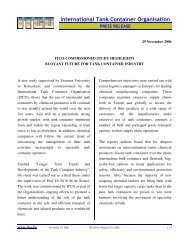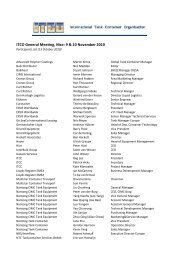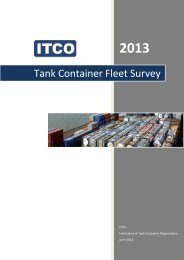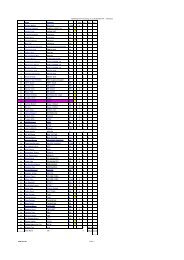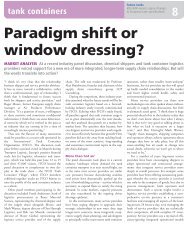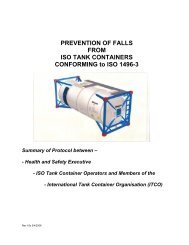Create successful ePaper yourself
Turn your PDF publications into a flip-book with our unique Google optimized e-Paper software.
ICHCA International <strong>Safe</strong>ty Panel Briefing Pamphlet No 30<br />
13.12Handrails<br />
13.12.1 <strong>ITCO</strong> recommend that hand rails are not fitted to tank containers - see<br />
also “Prevention <strong>of</strong> falls from ISO <strong>Tank</strong> <strong>Containers</strong> conforming to ISO 1496<br />
– 3” issued by <strong>ITCO</strong> (www.itco.be)<br />
13.12.2 Where the tank container is fitted from new with a permanently installed<br />
handrail, the handrail should be a minimum height <strong>of</strong> 1,100 mm in the raised<br />
position with at least one intermediate rail.<br />
Note 1: When handrails are installed on tank containers they must provide<br />
effective fall protection around all sides <strong>of</strong> the access and work<br />
area. Single handrails do not provide this and additional measures<br />
must be taken to prevent falls.<br />
Note 2: Handrails that are not securely retained when not in use can<br />
increase the risk <strong>of</strong> handling failures.<br />
13.13Use a fall arrest system, by far the best<br />
item <strong>of</strong> personnel safety equipment that<br />
can be employed. Operators should wear<br />
an approved harness and attach<br />
themselves to the overhead cables. In<br />
Picture 68 a number <strong>of</strong> “T” shaped<br />
stanchions are positioned about the area<br />
where an operator will work on the top <strong>of</strong><br />
the container. The connecting overhead<br />
cables have counterbalanced arrest drums<br />
supported from them to which the operator<br />
will attach their harness.<br />
13.14Do not overcrowd the top <strong>of</strong> the container. The walkways are limited in size<br />
and strength. Furthermore with too many people on the top <strong>of</strong> the container<br />
moving about can be hazardous.<br />
14 Inspecting <strong>Tank</strong> Container Interiors<br />
14.1 Under no circumstances should stevedores, dockworkers, ships crew,<br />
transport workers or customs <strong>of</strong>ficials, who have not been properly<br />
trained and equipped, open or enter any tank container, even if the<br />
container is declared as “empty”.<br />
14.2 When considering inspecting the interior <strong>of</strong> the tank container, one is really<br />
considering opening and entering a vessel which is an enclosed space. It<br />
should be remembered that the tank container will have carried a variety <strong>of</strong><br />
cargoes, some <strong>of</strong> which may be hazardous<br />
or cause an oxygen depleted atmosphere<br />
(i.e. little or no oxygen).<br />
14.3 Furthermore it is common practice that<br />
tank containers once they have been<br />
discharged may be only partially cleaned or<br />
filled with inert gases to be finally cleaned<br />
at the point <strong>of</strong> loading <strong>of</strong> the next cargo. In<br />
such cases the valves and hatches may be<br />
sealed during such transport as shown in<br />
Picture 69 (see also Annex 5 section A5.3)<br />
Picture 68<br />
Picture 69<br />
Page 43 ©ICHCA International Limited



